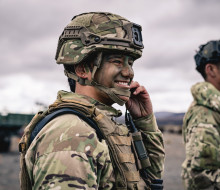
Keeping skills alive in transfer to Reserve Force
05 July 2024
Unfortunately you are viewing this website on an outdated browser which does not support the necessary features for us to provide an adequate experience. Please switch to a modern browser such as latest version of Google Chrome, Mozilla Firefox, Apple Safari or Microsoft Edge.
Ngā mihi nui
A proposal to hunt mines using uncrewed aerial technology has earned Sergeant Rick Henderson the Army Innovation Challenge 2023, Future Sight Category.
His entry, selected from 35 submissions earlier this year, provided background and justification to use geophysical remote sensing techniques for the detection of unexploded ordnance (UXO), land mines, improvised explosive devices (IEDs) and other explosive and pyrotechnic hazards (EPH) utilising an uncrewed aerial vehicle (UAV) and geophysical tools for detection.
SGT Henderson has clocked up 25 years as a geophysicist in the oil and gas industry, including international experience and running his own consultancy.
He says the development of a capability that can quickly and safely locate EPH would be beneficial for tactical and humanitarian purposes.
“Cluster munitions and land mines pose significant hazards to civilians and any future peacekeeping operations in affected countries like Ukraine and Syria.”
But closer to home could also benefit, he says.
“In the Pacific area, such as the Solomon Islands and Papua New Guinea, significant quantities of EPH from World War II exist, and here at home we have hazards scattered throughout our training areas. Locating items using remote methods could potentially save lives, and a quick remote detection capability could also minimise downtime during Live Field Firing activities and we are unsure of where rounds have landed.
“It could also be used in natural disasters where buried infrastructure or other items need to be located.”
In his entry, he says UAVs can have remote sensors that can detect modern munitions with very little metal, which are difficult to detect with traditional methods.
They could use hyperspectral imaging, with information gathered across infrared and visible light spectrums and processed pixel by pixel to detect abnormalities. UAVs could also utilise thermal imaging, radar pulses, magnetic surveying and attached metal detectors.
Army Innovation Manager, Captain James Firestone, says SGT Henderson’s idea generated significant enthusiasm among the judging panel.
Sergeant Henderson’s idea holds significant merit and is extremely current given the challenges with de-mining, both historical and current, with mines in many parts of Africa, Cambodia, Afghanistan, and most recently in the Ukraine.
“Navigating safely across minefields, especially when trying to breach an obstacle when assaulting, and de-mining are huge world issues. The Defence Force has already displayed significant worth in previous United Nations engagements, and I believe this could be something looked into for the future for elite 2 Engineer Regiment units to deploy for aiding in humanitarian missions. It could give New Zealand a high profile within this specialist area.”
He noted how SGT Henderson brought his significant civilian industry experience to his submission.
“He put forward a very novel and useful insight, which he can back up as a Subject Matter Expert within the commercial mining (petrochemical and precious metals exploration) industry. As a Reserve Force Senior Non-Commissioned Officer, he has added huge value to the Defence Force, which marries the best of industry with the best of military.”
Acting Deputy Chief of Army, Colonel van Welie, spoke of the importance of innovation for the future of the Army.
Thank you for putting effort into your submission. We need to focus on our people then our mission and your project has focused on people. We need to protect innovation as it is always focused on improvement, and comes from a good place.
Colonel van Welie recalled time he spent on deployment in Afghanistan where they encountered numerous IEDs. SGT Henderson’s development could have made things much simpler and safer for the soldier, he says.